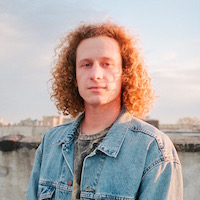More about Yasuo Kuniyoshi
Works by Yasuo Kuniyoshi

Contributor
Like many immigrants, Yasuo Kuniyoshi arrived in California as a teenager and did things like scrub floors and survive a NYC winter with no winter coat.
His parents weren’t exactly stoked on Yasuo’s trip to America, but once stateside he wouldn’t return until his father was proud of him. This ended up taking 25 years, when finally a Japanese newspaper sponsored a solo show of his work in Tokyo and Osaka and offered to fly him back. They’re paying for your flight? You’ve made it my son!
He had meant to become a translator but a high school teacher in Los Angeles suggested he become an artist, dooming him to a lifetime of second jobs. Even after his art career took off, he paid the rent with photography, apparently the hype over his art was “not negotiable at the grocery store.” Dude’s gotta eat...except for peanuts. “I’ve never forgotten the feeling of sitting day in day out in the harbor watching the big boats go by and eating peanuts...I’ve never eaten them since.”
Kuniyoshi went from munching soggy peanuts to the holy grail: artistic success before death . He remained active in the hyper-cannibalistic New York art scene for more than 30 years. The U.S. State Department paraded his work internationally, alongside Georgia O’Keeffe and Edward Hopper. He was the first living artist ever to get a retrospective at the Whitney.
There was one hiccup in his career, though, when he was mistaken for a humorist in his first solo exhibition. He devotes an entire paragraph in an essay to explaining himself: “I wasn’t trying to be funny but everyone thought I was. I was painting cows and cows at that time because somehow I felt very near to the cow. Besides, I thought I understood the animal. You see I was born, judging by the Japanese calendar, in a ‘cow year.’ According to legend I believed my fate was to be guided, more or less, by the bovine kingdom.”
Some of his most well-known paintings feature babies, for which he has a similarly philosophical explanation. “People think that babies are beautiful but I thought otherwise and so I painted babies and babies.” I’d have gone for the humorist label too.
But life wasn’t all jokes. He avoided the internment camps during WWII, but was branded an “enemy alien.” His bank account and camera were impounded and he had to apply for professional travel visas to cross state lines. He was never allowed to become a citizen, driving him to absurd (and, more absurdly, necessary) lengths to prove his allegiance during the war. He built a giant caricature of the Japanese emperor, denouncing his homeland’s leadership, and helped produce propaganda posters and speeches.
Still, a Kuniyoshi scholar insists that Yasuo killed it in America, “He was a party animal, he had a ton of friends, other artists loved him.” If he didn’t have so much fun raging with the squad he probably wouldn’t have been so hell-bent on being a citizen.
His desire to be a citizen is what eventually killed him. He drank, smoked, and otherwise partied himself into a hospital in the early fifties. From behind a veil of prescription meds on his deathbed, he asked his wife whether he’d gotten his citizenship. She lied and told him that yes, finally he was a citizen, and the relief killed him. Not exactly medically accurate, but you get it.
Sources
- “Box 1, Folder 12: ‘East to West, 1940.” Yasuo Kuniyoshi papers, 1906-2013. American Archives of Art, Smithsonian Institution. Accessed September 8, 2017. https://www. aaa.si.edu/collections/yasuo-kuniyoshi-papers-9175/series-3/box-1-folder-12
- Catlin, Roger. May 14, 2015. “Meet the Iconic Japanese-American Artist Whose Work Hasn’t Been Exhibited In Decades.” Smithsonian.com. Accessed September 7, 2017. http://www.smithsonianmag.com/smithsonian-institution/iconic-japanese-a…
- Khalid, Farisa. May 10, 2013. “For Heritage Month, Remembering ‘One of a Kind’ Painter Yasuo Kuniyoshi.” Asia Society Blog. Accessed September 7, 2017. http://asiasociety .org/blog/asia/heritage-month-remembering-one-kind-painter-yasuo-kuniyoshi
- Smith, Roberta. July 23, 2015. “Yasuo Kuniyoshi, a Modernist Often Overlooked, Gets a Smithsonian Retrospective.” New York Times July 24, 2015. Accessed September 8, 2017. https://www.nytimes.com/2015/07/24/arts/design/yasuo-kuniyoshi-a-modern…
- Smithsonian American Art Museum. August 3, 2015. “Bruce Dorfman recalls Yasuo Kuniyoshi.” Smithsonian American Art Museum: YouTube Channel. Accessed September 7, 2017. https://www.youtube.com/watch?v=2YDgLs6R04I
- Stamberg, Susan. August 13, 2015. “The Anxious Art Of Japanese Painter (and ‘Enemy Alien’) Yasuo Kuniyoshi.” NPR The Morning Edition. Accessed September 7, 2017. http://www.npr.org/2015/08/13/430374356/the-anxious-art-of-japanese-pai…
- Wang, ShiPu. Becoming American: The Art and Identity Crisis of Yasuo Kuniyoshi. Honolulu: University of Hawai’i Press, 2011. Accessed September 7, 2017. https://muse.jhu.edu /book/1750
Featured Content
Here is what Wikipedia says about Yasuo Kuniyoshi
Yasuo Kuniyoshi (国吉 康雄, Kuniyoshi Yasuo; September 1, 1889 – May 14, 1953) was a Japanese-American painter, photographer and printmaker.
Check out the full Wikipedia article about Yasuo Kuniyoshi














